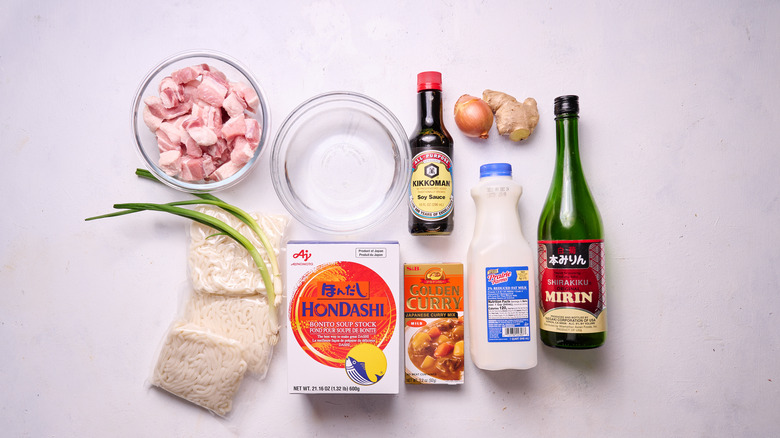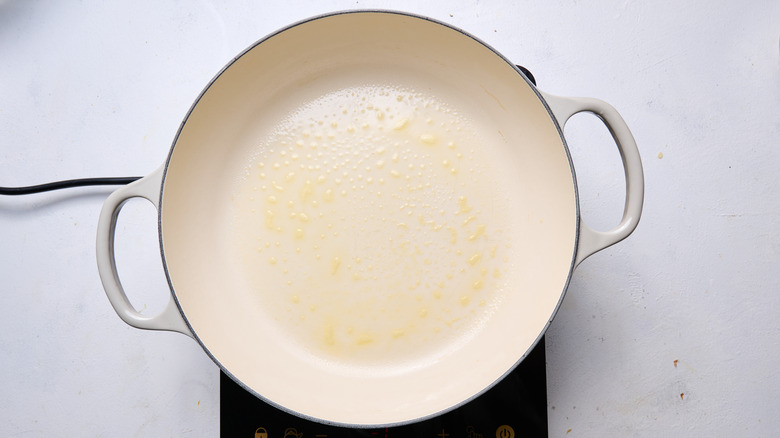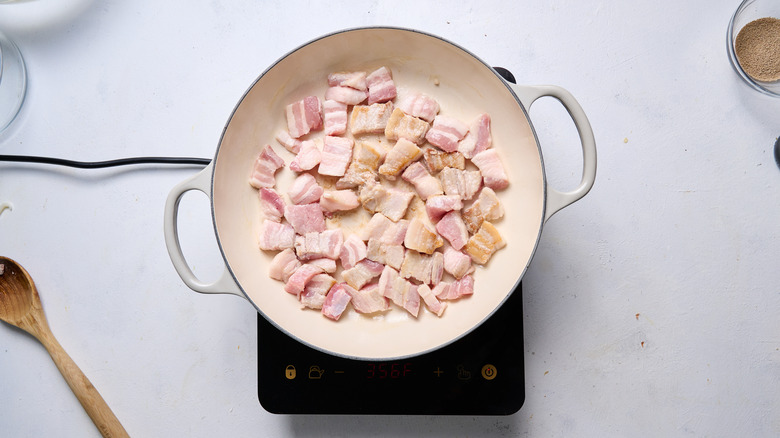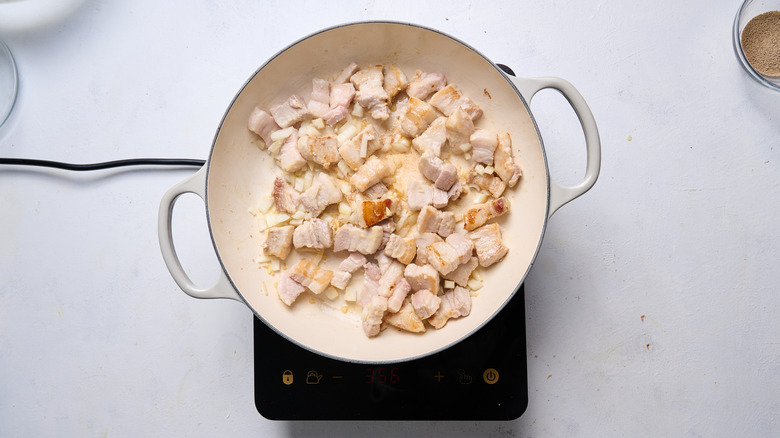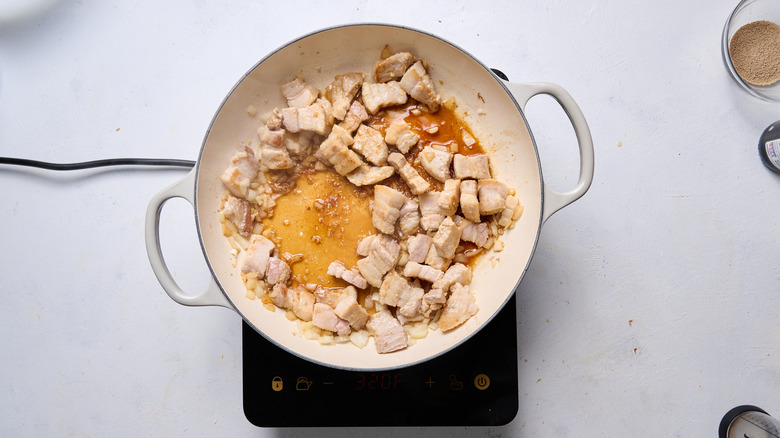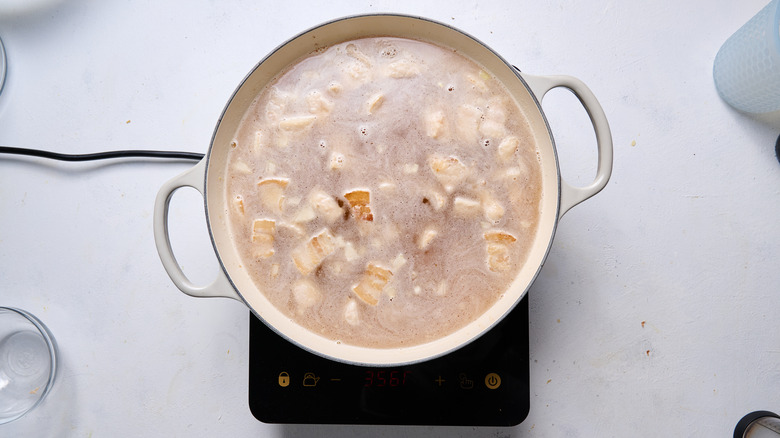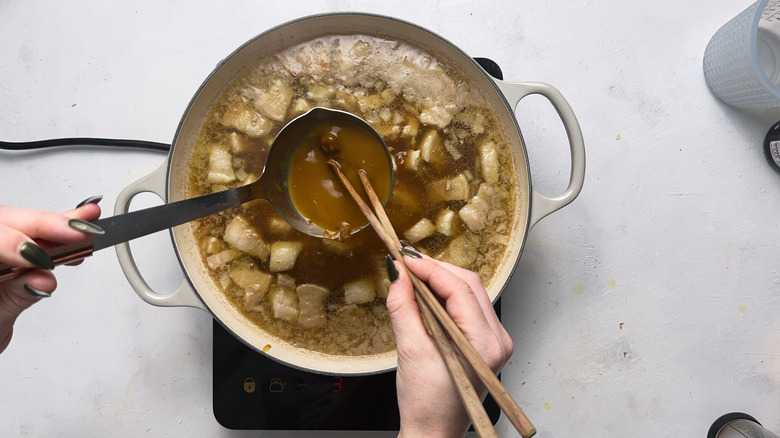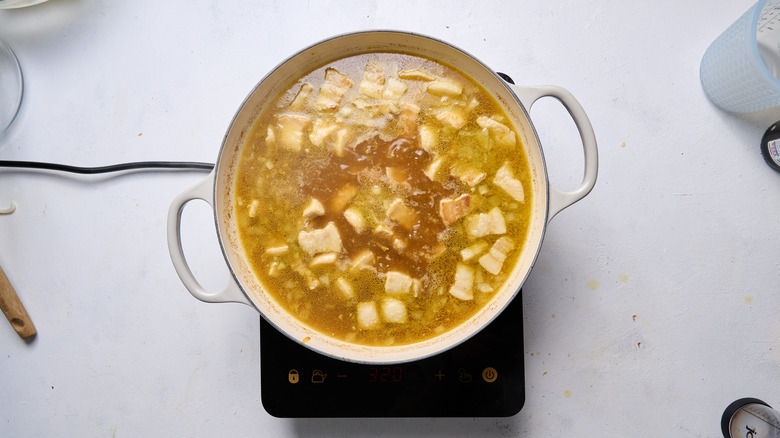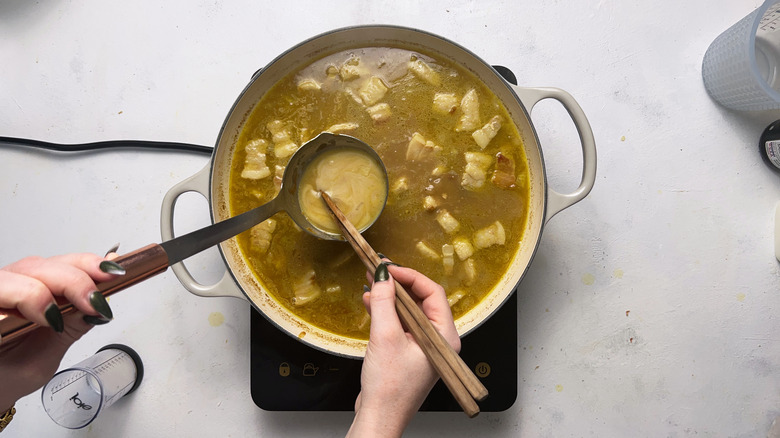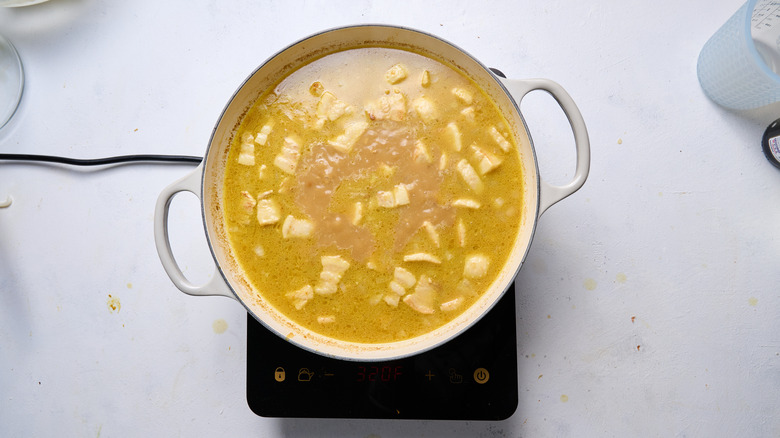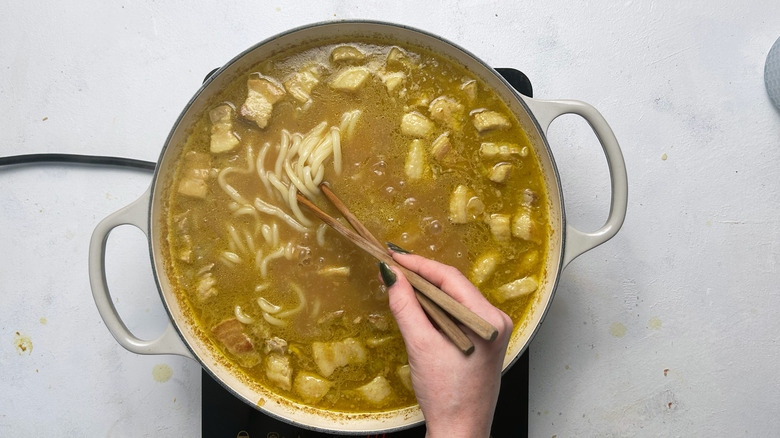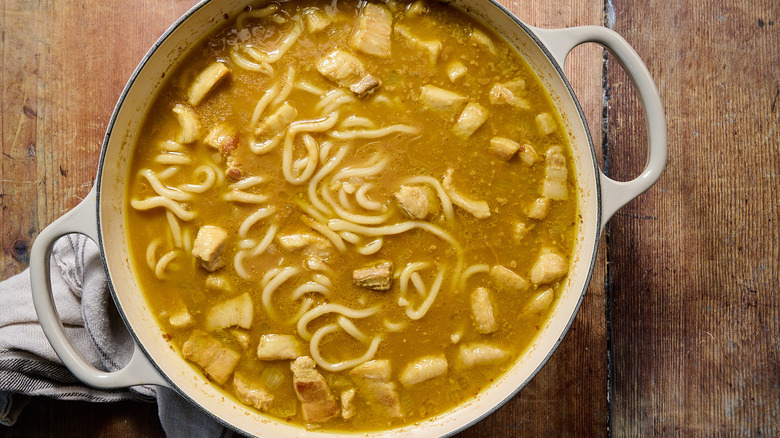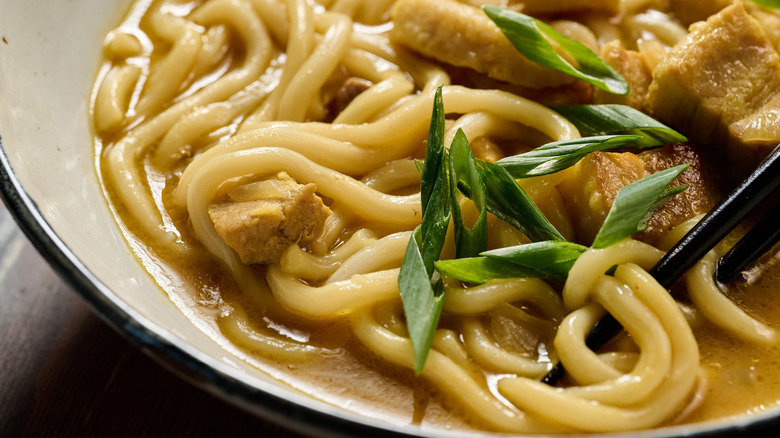Pork Belly Curry Udon Recipe
Curry udon is almost entirely what it sounds like: udon noodles lapping up a spicy curry sauce. Unlike Indian, Thai, and other types of curries, Japanese curry is a thick brown stew made with a flour-based roux. The idea behind Japanese roux isn't too dissimilar from the roux we know and love in Cajun gumbo, but the flavor is entirely different. Japanese roux is packed with spices like cardamom, cinnamon, clove, cumin, and turmeric. Paired with mirin, soy sauce, and dashi, this gives Japanese curry a warm, rich, umami base that can be spooned over sticky rice or served with udon noodles.
Udon is a classic type of Japanese noodle that is thick, round, and chewy, and when boiled into curry, it becomes silky and slurpable. Because this dish is so common in Japan, the roux is sold in cubes and fresh udon is frozen — so a delicious curry can come together in minutes. This version of curry udon by Michelle McGlinn uses curry roux, dashi, tender cubes of pork belly, and a secret ingredient — milk — to make a creamy, warming stew you can enjoy any night of the week.
Gather the ingredients for pork belly curry udon
Most importantly for this recipe, you'll need Japanese curry roux, which is often labeled as Japanese curry mix and sold in small cubes. There's only one type of curry roux (though spice mixes and flavors may vary by brand), but you can choose a heat level. Mild will be barely spicy at all, medium is comfortably spicy, and medium hot and hot are, well, spicy.
From there, you'll need ginger, onion, soy sauce, mirin, milk, scallions, and pork belly. You can swap the pork belly for thinly sliced beef, ground pork, or chopped bacon. You'll also need instant dashi to make a quick broth. The last thing you'll need for curry udon is the udon — we recommend buying fresh udon, which can be refrigerated or frozen and will cook quickly and maintain a silky texture.
Step 1: Prepare a pot on the stove
Place a deep pot or skillet over medium heat and spray lightly with oil.
Step 2: Cook the pork belly
Add pork belly pieces and cook until pale in the center and golden around the edges, about 5 minutes.
Step 3: Add the aromatics
Add ginger and onion and cook until very soft, another 5 minutes.
Step 4: Stir in the wine and soy sauce
Add soy sauce and mirin and stir to combine, scraping the browned bits from the bottom of the pot.
Step 5: Simmer the dashi
Add water and instant dashi, bring to a boil, then lower the heat and simmer the broth for 5 minutes.
Step 6: Temper and dissolve the roux
Lift a ladleful of hot broth from the pot and add the curry cubes to the ladle. Dissolve using a small spoon or chopsticks.
Step 7: Combine it with the rest of the pot
Add curry mixture to the broth and stir to combine. Bring to a simmer over medium heat.
Step 8: Temper the milk
Lift another ladleful of hot broth from the pot and stir in the milk to warm.
Step 9: Stir in the milk
Combine the tempered milk into the pot of broth.
Step 10: Boil the noodles
Add udon noodles and boil for 2-3 minutes, then carefully break blocks apart using chopsticks.
Step 11: Let the curry cool slightly
Remove soup from the heat and let cool for 3-4 minutes to thicken.
Step 12: Garnish and serve
To serve, garnish with scallions.
What ingredient substitutions will work in this pork belly curry udon recipe?
To make a true Japanese curry, try to source the ingredients listed before turning to alternatives. However, if you aren't able to check everything off your list, some substitutions will still taste delicious. If you can't find instant dashi, which are powdery flakes that can be boiled with water for an easy brothy base, opt for either homemade dashi, fish stock, or chicken stock.
Curry roux, the main ingredient in curry udon, is hard to substitute. The closest thing to it would be a bouillon cube, and even that is hardly similar. Instead, the easiest thing to do is make your own roux from scratch. This can be done by cooking flour, butter, spices, and curry powder together until deeply browned — the challenge, of course, is finding Japanese curry powder for a similar taste; you may be better off making your own blend of cardamom, cinnamon, cumin, turmeric, and the other spices.
The last ingredient that is essentials to curry udon is — you guessed it — udon noodles. If you can't find the udon noodles that are vacuum sealed and frozen or refrigerated, look for shelf-stable or dry udon noodles as the next best option. Dry udon takes a little longer to cook and is slightly more similar to linguine in texture, but with the characteristic sponginess of udon. If you can't find udon, you can use ramen noodles, spaghetti, or linguine instead.
How do I store leftover pork belly curry udon?
Curry udon stores well and can even be frozen. In fact, this curry is even better the next day, when the flavors have had a chance to meld. To store curry udon in the refrigerator, simply transfer the soup to a sealable container, let it cool, and store for up to 5 days. You can reheat the noodle soup in the microwave or gently simmer it on the stove. We recommend using an old or disposable container for this curry, as the brightly colored spices tend to leave stains.
Freezing curry udon takes a little more thought, but it can be done. The curry base freezes easily and can be stored for up to 3 months. To reheat, simply heat the curry broth until warm and simmering. The noodles, however, don't freeze well in the broth and should be removed before freezing to avoid ruining the curry's glossy, creamy texture. Instead, we recommend using fresh noodles when reheating the frozen batch, which can be added after the broth has come to a boil.
Pork Belly Curry Udon Recipe
Store-bought Japanese curry roux is the shortcut to this deeply savory, warmly spiced noodle soup with rich pork belly, chewy udon, and a creamy broth.
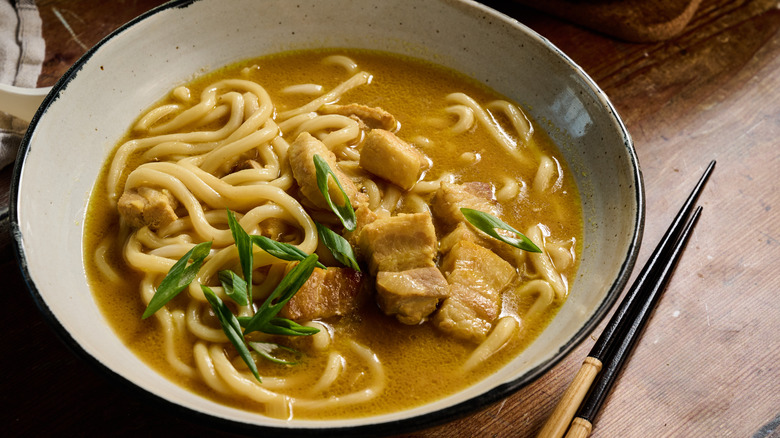
Ingredients
- 1 pound pork belly strips, sliced into 1-inch pieces
- 1-inch knob fresh ginger, peeled and minced
- 1 onion, diced
- 1 tablespoon soy sauce
- 1 tablespoon mirin
- 5 cups water
- 8 grams instant dashi (about 2 ½ teaspoons)
- 2 cubes Japanese curry roux/mix
- ¼ cup milk
- 3 servings fresh or frozen udon noodles
- 2 scallions, chopped, for serving
Directions
- Place a deep pot or skillet over medium heat. Spray lightly with oil.
- Add pork belly pieces and cook until pale in the center and golden around the edges, about 5 minutes.
- Add ginger and onion and cook until very soft, another 5 minutes.
- Add soy sauce and mirin and stir to combine, scraping the browned bits from the bottom of the pot.
- Add water and instant dashi, bring to a boil, then lower heat and simmer broth for 5 minutes.
- Lift a ladleful of hot broth from the pot and add the curry cubes to the ladle.
- Dissolve curry cubes using a small spoon or chopsticks.
- Add curry mixture to the broth and stir to combine. Bring to a simmer over medium heat.
- Lift another ladleful of hot broth from the pot and stir in the milk to warm.
- Combine the tempered milk into the pot of broth.
- Add udon noodles and boil for 2-3 minutes, then carefully break blocks apart using chopsticks.
- Remove soup from the heat and let cool for 3-4 minutes to thicken.
- To serve, garnish with scallions.
Nutrition
| Calories per Serving | 1,457 |
| Total Fat | 64.1 g |
| Saturated Fat | 22.8 g |
| Trans Fat | 0.0 g |
| Cholesterol | 83.2 mg |
| Total Carbohydrates | 173.3 g |
| Dietary Fiber | 8.0 g |
| Total Sugars | 8.3 g |
| Sodium | 295.4 mg |
| Protein | 41.3 g |

